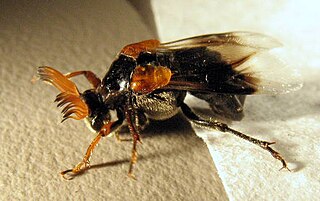
Convolvulaceae, known commonly as the bindweed or morning glory family, is a family of about 60 genera and more than 1,650 species of mostly herbaceous vines, but also trees, shrubs and herbs, and also including the sweet potato and a few other food tubers.

Halictidae is the second-largest family of bees with nearly 4,500 species. Halictid species are an extremely diverse group that can vary greatly in appearance. These bees occur all over the world and are found on every continent. Usually dark-colored and often metallic, halictids are found in various sizes, colors and patterns. Several species are all or partly green and a few are red, purple, or blue. A number of them have yellow markings, especially the males, which commonly have yellow faces, a pattern widespread among the various families of bees. The family is one of many with short tongues and is best distinguished by the arcuate basal vein found on the wing. Females in this family tend to be larger than the males.

Ripiphoridae is a cosmopolitan family of some 450 described species of beetles sometimes called "wedge-shaped beetles". Ripiphoridae are unusual among beetle families in that many species are hypermetamorphic parasitoids, an attribute that they share with the Meloidae. Members of the family differ in their choice of hosts, but most attack various species of bees or wasps, while some others attack cockroaches. Many species of Ripiphoridae have abbreviated elytra, and flabellate or pectinate antennae.
Lindigia is a genus of parasitic flies in the family Tachinidae. There are about five described species in Lindigia.

Atrytonopsis is a genus of butterflies in the skipper family, Hesperiidae. They are native to Mexico and the southwestern United States.

Lasioglossum vierecki, also known as Dialictus vierecki and Halictus vierecki, is a sand sweat bee and is part of the family Halictidae of the order Hymenoptera. It is found in the eastern half of North America from Minnesota to the New England States down to Georgia and Louisiana and up in Manitoba and Ontario. Commonly found in sandy areas, it pollinates various flowers such as grass-leaved goldenrod and rattlesnake master.
Polycyrtus vierecki is a species of wasp in the subfamily Cryptinae. It is found in Peru.

Ripiphorus diadasiae is a species of wedge-shaped beetle in the family Ripiphoridae. It is found in North America.
Ripiphorus schwarzi is a species of wedge-shaped beetle in the family Ripiphoridae. It is found in North America.
Didineis is a genus of wasps in the family Crabronidae. There are more than 20 described species in Didineis.
Atrytonopsis vierecki, or Viereck's skipper, is a species of grass skipper in the butterfly family Hesperiidae. It is found in North America.
Ripiphorus epinomiae is a species of wedge-shaped beetle in the family Ripiphoridae. It is found in North America.
Ripiphorus mutchleri is a species of wedge-shaped beetle in the family Ripiphoridae. It is found in North America.
Triploechus is a genus of bee flies, insects in the family Bombyliidae. There are about 10 described species in Triploechus.
Chrysotoxum chinook is a species of syrphid fly in the family Syrphidae.
Ammoplanops vierecki is a species of aphid wasp in the family Crabronidae. It is found in North America.
Ripiphorus sexdens is a species of wedge-shaped beetle in the family Ripiphoridae. It is found in North America.

Bathythrix is a genus of ichneumon wasps in the family Ichneumonidae. There are at least 60 described species in Bathythrix.
Animal Ethics is a nonprofit organization formed to promote discussion and debate around issues in animal ethics and to provide information and resources for animal advocates. They also do outreach work in several countries on the issue of speciesism. Their aim is to create a world where moral consideration is extended to all sentient beings. The organization's website covers topics such as speciesism, sentience, veganism and wild animal suffering and has content translated into several languages.





